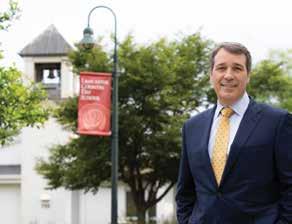
2 minute read
The Art of Science and Engineering
— Diane Wilikofsky, MS Arts Faculty
Advertisement


In Diane Wilikofsky’s classroom, the fifth graders inspected the small cardboardframed boxes with a mix of skepticism and curiosity, picking them up and peeking inside them in a vain attempt to uncover their purpose. Then Wilikofsky called for their attention, and the students turned and saw her holding an identical cardboard frame with a few additional parts, one of which was a crank attached to a wheel and axle. As soon as she turned the crank, Wilikofsky’s automaton lurched to life and the purpose of the frame became instantly clear: It was the skeleton of a mechanical creature not yet made. Today’s was not a conventional art class, though it certainly had elements of one; today’s class was a Makerspace. These are lessons in which hands-on creativity — and actually creating a physical thing — is the main idea. “But that’s only a part of it,” Wilikofsky explained. “It’s about problem-solving, brainstorming ideas, making and testing a solution, and then fixing any problems in redesign or even going back to the brainstorming stage.” In today’s exercise, students began by thinking about how they wanted their automaton to move — what they wanted it to do — and then sketching a design of how to accomplish that. For example, a figure that would rise and fall evenly with each turn of the axle would need to rest on an oval-shaped wheel. Making the figure dance in a more eccentric way would call for a more oblong wheel, while making it perform more intricate movements would require increasingly complicated assemblies. “One of the questions the art faculty has asked itself is not everybody is going to be an artist, so what can we teach so they get something from art?” Wilikofsky said. The Makerspace exercise is “a fun way to incorporate STEAM concepts into art.” While one class built cardboard automatons, another experimented with the basics of electrical networks by making bracelets with conductive wire sewn between batteries and LEDs so that they light up when the bracelet — and its built-in circuit — is closed. For all the fun Wilikofsky and her students have, and all that they’ve learned together, she stresses that the fledgling enterprise is still very much a work in progress. “What’s difficult is that kids want grades, and this can be frustrating for them because [the final product] is not an end. I want kids to take what they’ve learned and apply it to the next problem,” Wilikofsky said. “I want kids to take away life skills and to learn that failure’s OK. Nobody’s trying to fail, obviously, but so, OK, you failed. “What’s next?”








